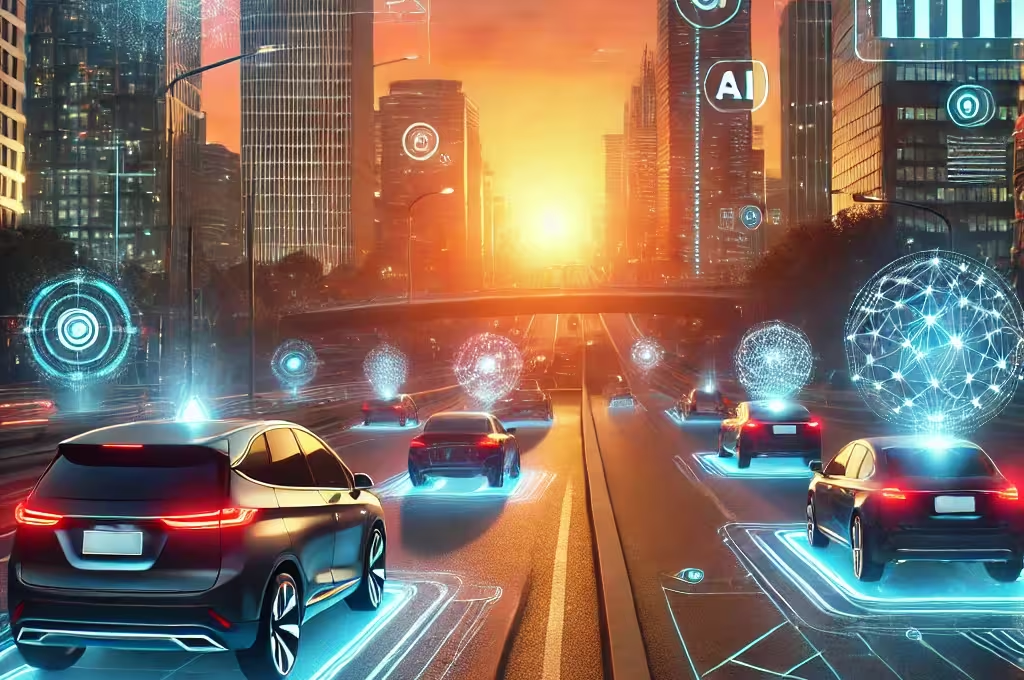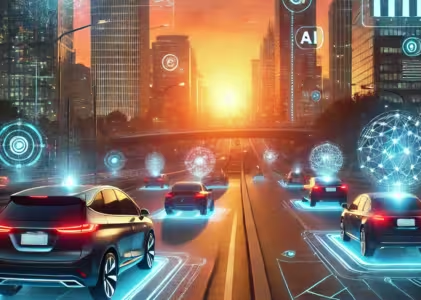Transformation of the Transport Industry due to AI – In this ultimate guide, we will explore how AI is changing every aspect of transportation, from fleet management to autonomous vehicles, and predictive maintenance to urban mobility.
This article will give you a closer look at what’s in store for the future of our movements. Real examples, case studies, and data will explain each topic in detail.
Introduction to AI in Transport: Why Now Matters
What is artificial intelligence in transportation?
Indeed, AI is already transforming all forms of transportation today-from effective fleet management to route optimization to the improvement of the passenger experience.
But what does AI in transport mean? In simple words, it means the use of machinery that can “think” and learn to make decisions that are traditionally controlled by humans. Transportation AI uses a segment of AI, machine learning, to predict, plan, and respond to make travel times faster, safer, and more efficient.
Timing couldn’t be better, because as the urban population grows, along with increasing levels of traffic congestion, AI could provide the solution needed for handling our evolving mobility.
AI in Fleet Management: How Does It Save Time, Money, and Resources?
Where does the actual streamlining of fleet operations take place?
Today, for a large number of fleet managers worldwide, AI can be a real game-changer. AI-powered software may help companies enhance route planning, fuel efficiency, and vehicle maintenance-all saving considerable time and money. How?
- Route Optimization: AI-enabled route planning software studies current traffic flow, prevailing climatic conditions, and many other factors to determine the shortest routes. For example, UPS uses AI to chart its delivery routes, which results in huge savings in fuel and labour costs.
- Fuel Efficiency and Cost Reduction: AI tracks driving behaviours like speeding or idling that impact fuel wastage. By pinpointing possible improvement areas, AI has truly enabled fleets to lessen fuel consumption and reduce their emission levels.
- Maintenance Alerts: AI does not just route but also keeps the vehicles running. Through machine learning algorithms, AI could analyze the vehicle data to decide when maintenance is required to reduce abrupt breakdowns. With these, it translated into fewer delays, lesser fuel consumption, and better vehicle uptime, thus sealing AI’s place within the fleet management process.
Autonomous Vehicles and Self-Driving Technology: How Close Are We to a Driverless Future?
What is the present state of autonomous vehicle technology, and what next?
It might sound like the stuff of fanciful science fiction, but the truth is that autonomous vehicles are being tested on public roads everywhere in the world. With companies like Tesla, Waymo, and Cruise leading in that direction, AI is used to help create self-driving cars able to navigate through streets and highways.
- How It Works: AVs depend on sensors, cameras, radar, and machine learning algorithms for detecting and interpreting their surroundings. Then, with this input, the AI “driver” will understand what is around it and make decisions in real-time, such as when to change lanes or stop for pedestrians.
- Status: While fully autonomous, self-driving cars have scope limitations and are usually tested under highly controlled environments, they are rapidly improving. This continuous improvement by AI increases the capability of these vehicles to handle difficult situations on city streets. It is expected that, shortly, autonomous cars may become common in ride-sharing fleets and may find widespread use in logistics and individual transport. There are, however, hurdles to be crossed: regulatory clearances, safety aspects, and ethics concerning decisions to be made in emergent situations.
Predictive Maintenance and Safety: Can AI Stop Accidents Before They Even Occur?
How does AI improve vehicle maintenance and safety?
The most significant positive impact of AI in transportation is to know just when a part might fail or how maintenance is needed. It’s called Predictive Maintenance. It goes like this:
- Data-Driven Maintenance: AI systems analyze data streaming in from vehicle sensors to estimate when a part may need to be replaced. This means fewer unscheduled breakdowns and safer journeys.
- Accident Prevention: AI will monitor driving patterns and warn drivers about any potential hazards, such as sudden braking or sharp turns, therefore reducing accidents. For example, AI-powered software in trucking firms analyzes driver behaviour and sends alerts to take a break or reduce speed. Predictive maintenance not only improves safety but also reduces the cost as time is not spent out of commission due to unexpected repairs.
Traffic Management and Smart Infrastructure: Can AI Reduce Congestion in Cities?
- Real-time Flow of Traffic: AI systems analyze real-time data from traffic cameras and sensors to change traffic lights, reducing congestion. For instance, AI-driven systems in Barcelona have reduced congestion by optimizing signal timings.
- Smart Infrastructure: Smart infrastructure includes connected traffic lights communicating with autonomous vehicles to drive down collisions and improve road utilization. AI-powered traffic management reduces travel time, lowers emissions, and promotes sustainable urban development.
Smarter Journeys through AI: How Can Travel Be More Personalized?
In what way does AI make journeys easier and more pleasant?
AI is also changing the passenger experience to make travel more comfortable and personalized:
- Personalized Recommendations: AI by airlines and ride-sharing services does not simply recommend the best travel time and route but also suggests entertainment options, based on a passenger’s tastes and preferences. Examples include Delta Airlines, using AI to improve customer service through anticipating needs with travel patterns.
- Real-Time Updates: AI-powered apps provide passengers with real-time updates to enable flight tracking, delays, or traffic situations and thus plan accordingly. With AI, transportation can become tailor-made for the needs of each journey and hence more pleasurable and efficient.
Environmental and Ethical Considerations: What Are the Trade-Offs?
Is AI transport sustainable, and are ethical concerns appropriate?
As we go with AI in transportation, environmental and ethical implications have to be reckoned with.
- Environmental Impact: By optimizing driving paths and driving economically, AI might contribute to lower emissions. The energy consumption from the processing of data is also relatively high by comparison. Balancing these benefits with a lot of carbon footprint by AI, especially in the case of large-scale operations, is quite challenging.
- Ethics and Privacy: Also, there is an ethical interest in AI playing a decision-making role. For instance, in an unavoidable accident, should a self-driving car sacrifice its passengers or pedestrians? These feelings will be vital in the future as AI continues to shape our transport systems.
Future of AI in Transport: What’s Next?
Question: What is next for AI in transportation?
The ambition for AI in transport is only set to grow from hyperloop technologies promising near-supersonic travel to high-speed rail systems managed by an AI overlord. As AI grows in sophistication, deeper will be its embedment in our transport networks to make travel safe, quick, and efficient.
What’s Next? | AI in the Transport Industry
With each new day, AI technologies can improve and offer solutions totally from the future. While there are yet challenges and lots of questions to answer, one thing is for sure: AI in transport ceased to be a vision but has already become a reality, which changes our lives.
For those who were thrilled by technological progress, that is just the beginning. Expect more intelligent, active, responsive, and personalized ways of moving from one place to another as AI technology accelerates.
Reader Takeaway: The use of AI in transport is opening new doors for fleet management, safety, and passenger experience.
Of course, not all of the challenges are insurmountable; yet, the prospect of AI ushering in safer, greener, and more efficient ways to move people and goods is exciting. The future of AI in transport may be transformative and may rewrite how we relate to the world around us.
More From Us
What is Cloud Computing Cyber Security?
How data Security can be implemented
The Science Behind Global Warming
FQAs on AI in the Transport Industry
1. What would the future of transportation be?
Transportation in the future is surely going to be characterized by sustainability, efficiency, and automation.
The more AI is developed, the more we should expect to see self-driving vehicles, better management of traffic flow. And modes of transport that are friendly to the environment, such as electric-powered and hydrogen-powered vehicles.
Innovations in hyperloops and autonomous drones that deliver items could turn out to be the norm and revolutionize the way people and goods are transported.
2. Which three of the following are some of the largest trends in the future of transportation?
The three biggest trends in transportation that are going to shape the face of its future are. Automation, electrification, and smart infrastructure.
Automation entails self-driving vehicles and AI-assisted fleet management, while electrification is going into electric and renewable energy vehicles. And smart infrastructure incorporates technology into roads and traffic systems to improve safety while easing congestion.
3. How is technology going to change transportation in the future?
New transportation methods are a venue of speed, safety, and efficiency due to technology. AI will be optimizing routes, automating functions of vehicles, and personalizing passenger experiences.
Meanwhile, greener transportation is attained with innovations in electric and hydrogen fuel technology. While smart traffic systems maintain congestion at a minimum with advances in connectivity.
4. What does the future of transportation mean?
Future transport describes new and innovative ways and systems to move people and goods around in the most efficient. Sustainable manner, and safely.
It includes self-driving vehicles, AI-assisted logistics, electrified fleets, and smart city infrastructures designed to minimize environmental impact. Improve access, and enhance user experience.
5. How will AI improve transportation safety?
AI improves the safety of transport through predictive maintenance, real-time monitoring, and accident prevention systems.
Predictive maintenance deploys AI to predict any issues of malfunction. In a vehicle before they happen, while AI-powered systems monitor driver behaviour and send alerts. Thereby over time reducing accident rates and ensuring safer journeys for all.


